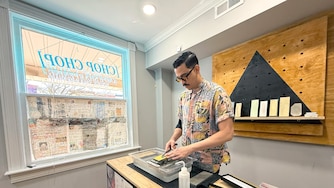For 10 years, Pitango’s Ann Street location has served its baked goods, sandwiches and other café fare to customers in Fells Point. Now, for the first time, patrons can get pizza, too.
The bakery rolled out a new pizza program this summer that CEO Dinah Bengur says was inspired by an international work trip. But it’s far from the only restaurant getting in on the pizza game. Across Baltimore, pizza is popping up on menus that you might not expect.
Less than a block away from Pitango, guests to bakery Sacré Sucré can now order pizza on Thursday and Friday nights. In Harbor East, Cinghiale just introduced Abruzzese-style pizza. Cosima in Hampden added more pizza to its menu last year, while Remington shop Doppio Pasticceria has gained an avid following — and out-the-door lines — for its New York-style pies.
The options should only continue to grow. In the former home of Doppio Pasticceria at 2600 N. Howard St., owners of the überpopular pastry shop Café Dear Leon are set to open La Maison, which will serve wood-fired pizza.
And Atwater’s, the local chain known for its soups, sandwiches and breads, recently started bimonthly pizza pop-ups at its Catonsville branch. The dish could be a major part of the brand’s strategy moving forward.
So what’s driving the pizza craze? For starters, almost everyone likes it. First introduced to American diners in the 1900s (or possibly earlier), pizza has only grown in popularity as nostalgic comfort food and an easy solution to the daily dinner dilemma. It’s such a ubiquitous part of our diets that it’s become a symbol of the state of the economy: Experts say sales of frozen pizza, which topped $7 billion last year in the U.S., are a possible recession indicator, according to Food & Wine.
Read More
For independent restaurant owners, pizza can be an efficient and low-cost way to expand their menu, said ZaVino owner Gino Kozera. While the custom Marra Forni pizza oven at his Cross Keys eatery cost tens of thousands of dollars, simpler versions are significantly cheaper. “You can do it without a huge, huge investment,” he said.
That was certainly part of the calculus for Pitango. “It’s basically using all the toppings or ingredients we already had,” Bengur said. She had been looking at ways to bring more evening customers to the Ann Street location, which boasts a large patio overlooking the water. The bakery, where the pizza is baked in the same ovens as other goods, is the only one of Pitango’s seven branches currently offering the dish.
Inspiration hit while Bengur was in Italy on business and sampled pizza alla pala. The Roman-style flatbread, typically served on a wooden paddle, is oblong in shape with a light, crispy crust and a fluffy interior. Staff at Pitango spent five months perfecting their own recipe before rolling out the new menu in July. Customers can order whole pies — including margherita, ’nduja and mortadella and stracciatella versions — or get any three slices for $10.
At Sacré Sucré, co-owner Manuel Sanchez said pizza was a no-brainer for the shop’s new location on Fell Street, which opened last year. The building was previously home to a pizza shop and already had a pizza oven. And as bakers, Sanchez said, “We already had the mixers, we already had the flours.”
Pizza, which is relatively inexpensive to prepare, can also be a more profitable dish for restaurants to serve in contrast to more protein-heavy or labor-intensive meals. That’s no small consideration for business owners at a time of skyrocketing food and labor costs. At Pitango, tariffs have impacted products like prosciutto — which the company imports directly from Italy — as well as coffee and sugar.

Then again, adding pizza isn’t necessarily a recipe for success for each business. At Sacré Sucré, Sanchez said the business has struggled to figure out its dual identity as pastry shop and pizzeria, and to get the word out to customers about the new offerings. “It’s not going as good as we would have wished for,” he said.
On evenings when they make pizza, Sanchez and co-owner Dane Thibodeaux decided not to serve the more intricate pastries for which the shop is known. “We fear that if we are still offering pastries, the pizza might suffer and vice versa,” he said.

Most business owners are still reticent to raise menu prices to keep pace with their own rising food costs, fearful of turning off budget-conscious customers amid economic uncertainty. Across the restaurant industry, Ned Atwater said, “The margins have all but disappeared.” The Atwater’s founder is constantly looking at creative ways to cut waste and get business costs down.
But Atwater said it’s not the pursuit of higher profits that inspired him and head baker Mike Hynes to explore the finer points of pizza making. They just really, really love pizza. The restaurant’s version, which Hynes whipped up for a staff meal a few times, is made with a high-hydration pizza dough, which stays crispy and moist after baking, and is topped with house-made sauces and cheese.
For now, customers who want to try an Atwater’s pie will have to keep an eye out for the company’s pop-ups every other month, which typically sell out. The success of the dish may help chart a new path for the company as Atwater considers permanently adding it to the menu, or even launching a spot that specifically focuses on pizza.
“Maybe it’s time to do something a little different,” he said.




Comments
Welcome to The Banner's subscriber-only commenting community. Please review our community guidelines.